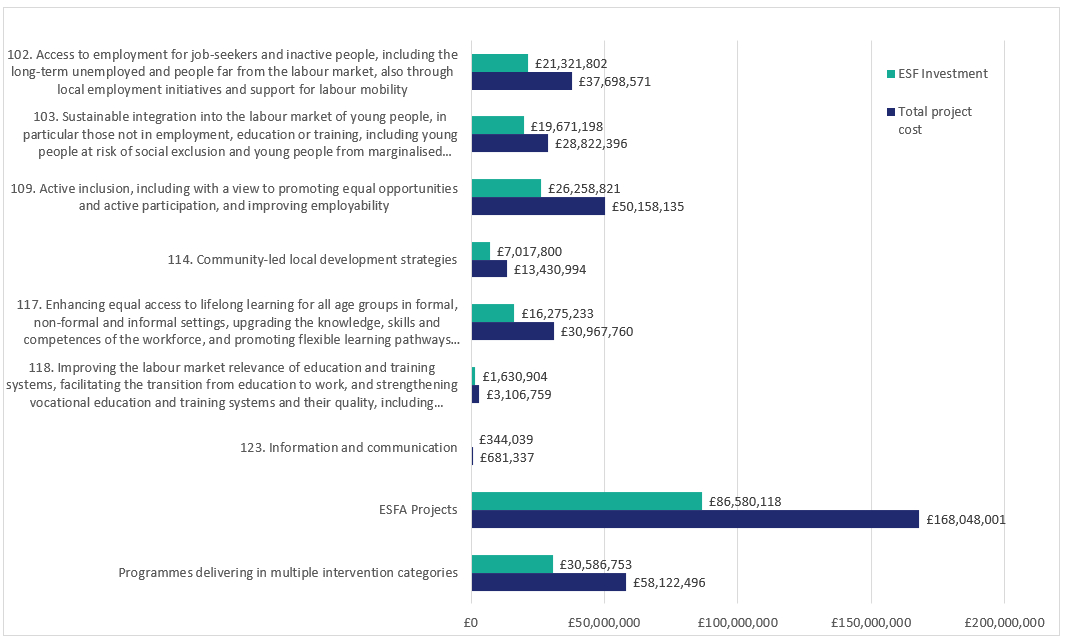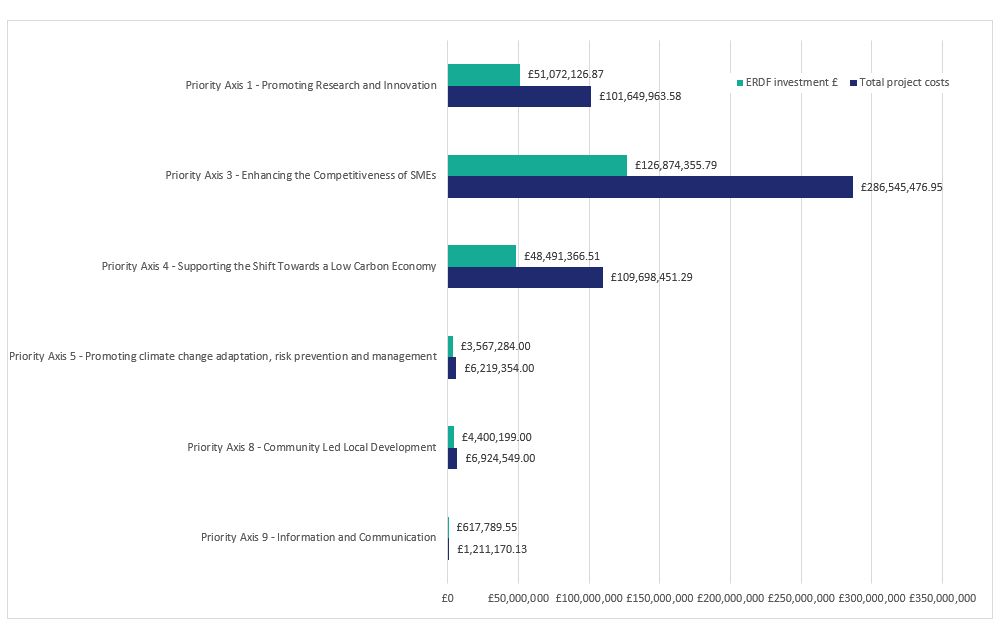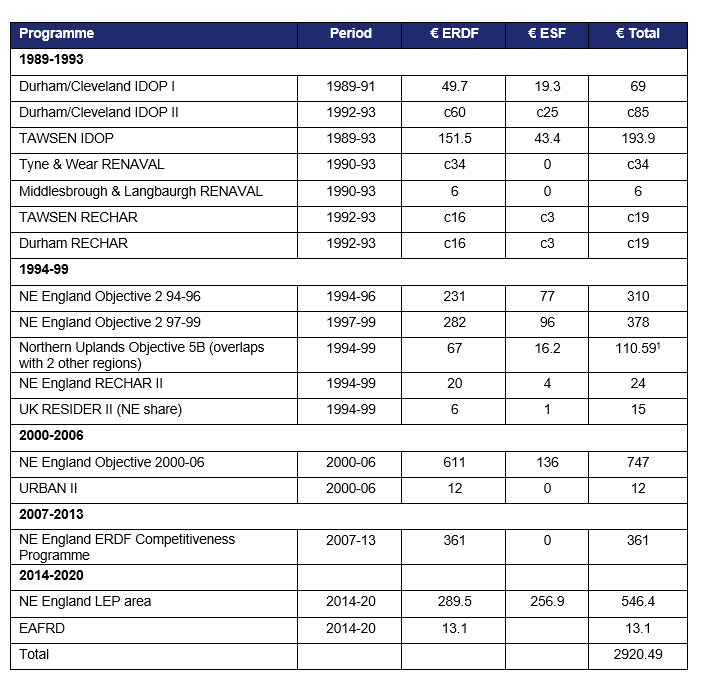In the 1970s and 1980s the North East was viewed as a declining industrial region, this was exacerbated by the 1980s recession and the decline of traditional industries, which led to the loss of 100 000 jobs (10% of the workforce). Structural Funds support was introduced in response to these issues as regeneration was needed to address derelict and polluted land and to provide retraining, social support and infrastructure investment. The 1980s saw a focus on; targeting new investment in particular from Asia; a new focus on small enterprises; and physical developments to change the image of the region. Following acknowledgement of the limitations of an inward investment-based strategy in the 1990’s, the region developed an alternative strategy focused on innovation under One North East.
Context
Timeline of Investment Programmes
Funding streams
The following resource steams have been available to the North East:
- EU Structural Funds – with sub-programmes related to regional competitiveness (ERDF) and Social programmes (ESF) with smaller funds dedicated to particular priorities from time to time
- Regional agency programmes from UK funds: RDAs (Single programme), LEP’s (LGF)
- Support for business investment in designated areas, initially through regional selective assistance, but more recently through the Regional Growth Fund
- Urban regeneration schemes with national funding
- Rural development programmes
- Local authority initiatives
- Employment initiatives targeted at individuals and places
- Enterprise Zones
Timeline of structural funding
Since 1989, 7 year multiannual programmes have funded a variety of public, private and non-profit organisations on a matched funding basis. The main sources of funding have been the European Regional Development Fund (ERDF) and the European Social Fund (ESF), but there have been additional smaller streams of funding for rural development (European Agricultural Fund for Rural Development - EAFRD), fisheries etc.
Expenditure
Expenditure on regional programmes (including matched funding) peaked at levels of just under 1% of regional GDP in the late 1990’s, falling in the late 2000s to a typical annual level of 0.2% of regional GDP. Overall the scale of EU expenditure relative to regional GDP places constraints on what we might expect the programmes to contribute to changes in regional level performance.
To illustrate the overall spending contribution of regional funding, the table below identifies the overall value of the RDA spending (including structural funds) as a proportion of public spending in the regions.
Detailed patterns of spend are available for the period up to 2010 from monitoring reports made available through a previous evaluation study on the structural funds, however such monitoring reports are no longer easily accessible for the period 2011 to 2014. Since then under the new 2014-20 programme monitoring reports have only been available at England level and these do not easily identify regional spend.
LEADER
Parallel to the main ERDF/ESF programmes has been a 20-year investment in rural development from successive LEADER programmes. LEADER has been implemented through rural development programmes and funded by the European Agricultural Fund for Rural Development (EAFRD). Implementation is through Local Action Groups. The North East currently has four LEADER areas:
- Northumberland Coast and Lowlands
- Northumberland Uplands
- North Pennine Dales
- Durham Coast and Lowlands
LEADER funding is relatively small sums, so the North Pennine Dales area has a current budget of £2.406m for 2015-20, and Northumberland Coast and Lowlands has £2.481m. The funding is focused on small projects around rural development, farm and forestry productivity, rural tourism and the provision of rural services.
The 2014 - 2020 Programme
As is set out above, a different approach was taken in 2014-2020, with single operational programmes established for England, Scotland, Wales and Northern Ireland with the North East part of the England programme.
Local Enterprise Partnerships were tasked to set down an investment programme (ESIF programme) for their area and to convene a European Steering Committee to work with the central programme management team to assess and prioritise projects.
The Investment programme aligned the ESIF programme to the North East Strategic Economic Plan enabling strategic alignment with other programmes including the Local Growth Fund, Enterprise Zones and other investment proposals as well as to the EU 2020 agenda to create the right environment for smart, sustainable and inclusive growth.
Three programmes were developed through the European Regional Development Fund (ERDF), European Social Fund (ESF) the European Agricultural Fund for Rural Development (EAFRD) and European Maritime and Fisheries Fund (EMFF). Whilst all of the programmes were managed nationally, the Government has continued to use the SEP as a vehicle to focus funding on local priorities with the exception of EMFF which is much smaller and is managed nationally.
The North East LEP area has two separate notional allocations for ESIF funding; these allocations split between:
- Durham: which has the status of a ‘transition region’ due to its relatively lower economic performance (between 75-90% of the European average GDP); projects could secure up to 60% of ESIF funding 2
- Tyne and Wear and Northumberland: which is classed as area is classed as ‘more developed’ which means its economic performance is 90% or above the European GDP average; projects in this area secured up to 50% of ESIF funding
The three programmes were focused as follows:
- ERDF: focusing investments on innovation and research; the digital agenda; support for small and medium-sized enterprises (SMEs); and the low-carbon economy. ERDF action aims to reduce economic, environmental and social problems in urban areas, with a special focus on sustainable urban development, through ‘integrated actions’ managed by cities
- ESF: aiming to help people get better jobs and ensuring fairer job opportunities for all. ESF works by investing in Europe’s human capital: its workers, its young people and all those seeking a job, in particular those who find it difficult to get work.
- EAFRD: focusing on rural development, by helping rural areas to meet economic, environmental and social challenges and opportunities in the 21st century, also in line with overall Common Agricultural Policy objectives. It has three long-term strategic objectives for EU rural development policy; fostering the competitiveness of agriculture; ensuring the sustainable management of natural resources, and climate action; and achieving a balanced territorial development of rural economies and communities including the creation and maintenance of employment
Whilst an allocation of funds to individual LEPs was made in accordance with their assisted area status (transition/more developed) less the allocation of ESF, it has been large organisations in the region which have led delivery of the programme given the need for technical leadership of projects. The impact was that there has been a relatively limited set of partners leading projects, compared with previous programmes, with an expectation that projects will be relatively large in scale. Local authorities have taken on the role of accounting bodies for a variety of smaller scale partners within their areas in programmes like community local economic development.
The biggest allocation of funding is to the North East Fund for the follow on to the Jeremie fund to support new and growing businesses. After this and the local authorities (Durham, Gateshead and Sunderland in particular) are big players, the universities (Sunderland, Newcastle, Northumbria) and innovation organisations have been important parts of the programme plus business support (in Northumberland particularly). A particular driver to this trend has been challenges securing match funding given restrictions on a minimum size of projects in response to the centralised and slimmed technical administration.
The figure below breaks down the ESF investments by category of investment.
The figure below illustrates ERDF investment by priority axis. 
A full profile of North East projects is available to download here.
This overview was informed by previous evaluations conducted by senior academic, David Charles based at Northumbria University.




